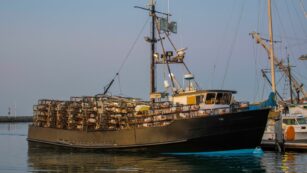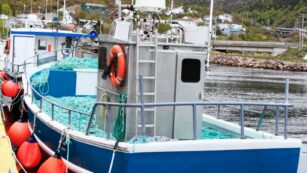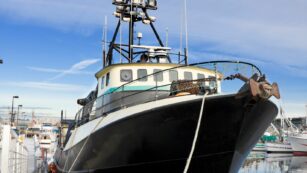Imagine setting sail on the crisp blue waters, heading towards the bounty of the sea with the thrill of the catch firing up your spirit. Destination crab boats offer just this, an adventure where the salty sea air mixes with the excitement of hauling in nets teeming with crabs. It’s not just a journey; it’s an escape into the heart of marine life, promising both challenge and reward.
Destination Crab Boat
 A destination crab boat operates specifically for capturing crabs in various oceanic regions. Typically built to withstand harsh sea conditions, these vessels are robust and well-equipped. They feature advanced navigation systems, sturdy crab pots, and spacious decks that facilitate the sorting and storing of crabs. Occupants of a destination crab boat often spend weeks or even months at sea, embracing a routine that blends rigorous fishing tasks with the management of onboard resources.
A destination crab boat operates specifically for capturing crabs in various oceanic regions. Typically built to withstand harsh sea conditions, these vessels are robust and well-equipped. They feature advanced navigation systems, sturdy crab pots, and spacious decks that facilitate the sorting and storing of crabs. Occupants of a destination crab boat often spend weeks or even months at sea, embracing a routine that blends rigorous fishing tasks with the management of onboard resources.
- Adventure and Excitement: Engaging in crab fishing presents a thrilling challenge, as crew members battle the elements to haul in lucrative catches.
- Economic Incentive: High market demand for crabs, examples being Dungeness and king crabs, offers substantial financial rewards for successful expeditions.
- Camaraderie and Teamwork: Life aboard a crab boat fosters strong bonds among the crew, as they depend on each other for safety and efficiency.
- Connection with Nature: Participants appreciate the raw beauty of the sea and the opportunity to work closely with marine environments.
Key Destinations for Crab Boating
 Destination crab boats frequently navigate the prolific waters of the Bering Sea, renowned for its abundant king crab populations. Experts pinpoint this region as a top destination due to its vast stretches where crabs thrive, largely due to the nutrient-rich waters. The Bering Sea not only promises abundant catches but also challenges crews with its formidable weather conditions, testing the resilience and skill of those aboard.
Destination crab boats frequently navigate the prolific waters of the Bering Sea, renowned for its abundant king crab populations. Experts pinpoint this region as a top destination due to its vast stretches where crabs thrive, largely due to the nutrient-rich waters. The Bering Sea not only promises abundant catches but also challenges crews with its formidable weather conditions, testing the resilience and skill of those aboard.
Further south, the Gulf of Alaska is another prime location for crab boating. This area is celebrated for its significant stocks of snow crabs. The Gulf’s diverse marine ecosystem supports a healthy crab population, making it an ideal spot for seasonal crab harvests. Boaters in this region benefit from its relatively more stable weather compared to the Bering Sea, which allows for longer, more productive fishing periods.
Preparing for a Crab Boating Trip
Check Weather Conditions Regularly
Before embarking on a crab boating trip, it’s crucial to monitor weather forecasts closely. Safe sea conditions are essential, as the ocean can be unpredictable. Storms, which often accompany rough seas, pose significant hazards to crab boating.
 Ensure Proper Gear is Available
Ensure Proper Gear is Available
All crew members must have access to appropriate safety gear. This equipment includes, but isn’t limited to, life vests, survival suits, and emergency beacons. Regular checks ensure all gear is in optimal condition and readily accessible.
Conduct Routine Boat Inspections
Maintaining the crab boat in top working order is a priority. Routine engine checks, hull inspections, and ensuring navigational tools are functioning properly are all critical tasks. These checks help prevent mechanical failures at sea.
Follow Established Safety Protocols
Crews should undergo regular training on safety protocols. These practices include man-overboard procedures, fire safety drills, and first aid training. Familiarity with these procedures can make a significant difference in emergency situations.
Maintain Communication Devices
Effective communication tools are vital while out at sea. Ensuring devices such as marine radios and satellite phones are functional and accessible can aid in emergencies and regular check-ins.
The Economic Impact of Crab Boating
Exploring the economic impact of crab boating reveals its significant contribution to local economies. Through the hard work and dedication of crews who navigate the demanding conditions of the sea, crab boating not only provides a livelihood for many but also supports seafood industries and tourism in coastal communities. Whether it’s the bustling markets of the Chesapeake Bay or the remote docks of the Bering Sea the industry plays a pivotal role in sustaining regional economic health.
For those considering a journey into the world of crab boating it’s clear that this adventurous endeavor is more than just a challenge—it’s a vital part of a larger economic tapestry. With the right preparation and respect for the sea crab boating offers an opportunity to be part of a storied and economically crucial tradition.

